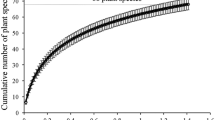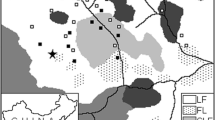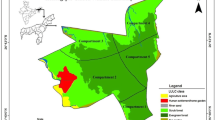Summary
-
1.
It has been reported that when the vegetarian Bush hyrax Heterohyrax and the Rock hyrax Procavia are allopatric they occupy an almost identical niche, while when sympatric they differ in feeding behaviour. To investigate whether indeed a displacement in feeding behaviour takes place where Procavia johnstoni and Heterohyrax brucei occur sympatrically, the feeding characteristics of three (two H. brucei, one P. johnstoni)allopatric family groups and four (two of each species) sympatric family groups living on five kopjes in the Serengeti were studied and compared.
-
2.
The vegetation of these five kopjes was surveyed. It was divided into four classes (grass, forb, bush, tree), the plant species identified and the indices of diversity and similarity calculated. The plant biomass was roughly quantified through a foliage density (f.d.) factor and the seasonal variation of vegetation recorded.
The number of plant species ranged from 65 to 95 (Fig. 4). The closer the kopjes are geographically, the greater the resemblance in their plant species composition (Fig. 6). Although bushes and trees comprise the fewest plant species (15–27%) they form the highest foliage density values (65–85%; Table 1, Fig. 5).There is a substantial variation of plant species diversity. A significant correlation exists between the diversity indices and crown cover, but there is no correlation between diversity indices and a) kopje area or b) the quotient of total number of hits per transect length.
Grasses, forbs and small bushes observe more or less the rainfall pattern, while other bushes, and trees, never completely lose their leaves (Fig. 7).
-
3.
The behaviour of individuals in the groups was regularly observed and recorded in the wet and dry seasons.
-
a)
H. brucei was observed feeding on 64 plant species (Annex A) but 2\2-11 species formed 90% of the animals' staple diet. There is a high correlation (r s=0.90) between the comparative abundance of vegetation (measured by f.d.) and the proportions of the four vegetation classes eaten by H. brucei (Fig. 8). All four family groups fed roughly in proportion to the foliage density, yet showed preference for certain plant species. They browsed predominantly on bushes and trees in the wet (81%) and dry (92%) seasons (Fig. 11), but showed a tendency to eat more grass and browse less in the wet season. There are marked differences in feeding between the family groups, due to selective preferences and the vegetation composition in the respective kopjes (Table 2, Fig. 10).
-
b)
P. johnstoni was observed feeding on 79 plant species (Annex A). The animals have a high seasonal adaptability: in the wet season they showed a high preference for grasses (78%), but in the dry season when grasses became parched and poor in quality they browsed (57%) extensively (Fig. 11), and more or less in proportion to the foliage density of each vegetation class (Fig. 9).
P. johnstoni must go outside the kopje to graze. Around one kopje the cropped grass area was very marked, its size varying with rainfall (Figs. 12 and 13).
-
a)
Competition for food could occur especially in the dry season when both species browse. However, no evidence could be found for a competition-induced displacement here.
-
a)
-
4.
Almost no aggressive behaviour was observed between the species.
-
5.
Both P. johnstoni and H. brucei have morning and evening feeding activity peaks in the wet and dry seasons, the evening one always being higher (Fig. 14). There was no indication in sympatric groups of any activity shift induced by the presence of the other species.
Evidence on the social character of group feeding and the guarding function of the territorial ♂ ♂ is presented.
-
6.
The results obtained are compared with those of other authors. There is no indication of niche segregation in sympatric kopjes. Possible climatic and other reasons for regional sympatry are discussed.
The advantage of selecting food items rich in protein and energy and low in fibre content are considered and food competitors listed.
Similar content being viewed by others
References
Anderson, G. D., Talbot, L. M.: Soil factors affecting the distribution of the grassland types and their utilization by wild animals on the Serengeti Plains, Tanganyika. J. Ecol. 53, 33–56 (1965)
Bartholomew, G. A., Rainey, M.: Regulation of body temperature in the Rock hyrax, Heterohyrax brucei. J. Mammology 52 (1), 81–95 (1971)
Bell,R. H. V.: The use of the herb layer by grazing ungulates in the Serengeti. In: Animal populations in relation to their food resources. British Ecol. Soc. Symposium No. 10, A. Watson, ed., p. 111–124 (1970)
Bell, R. H. V.: A grazing ecosystem in the Serengeti. Sci. Amer. 225, (1), 86–93 (1971)
Bothma, J. du P.: Hyracoidea. In: Preliminary identification manual for African mammals, J. Meester, ed. Washington D. C.: Smithsonian Inst. 1966
Braun, H. M. H.: Primary production in the Serengeti; purpose, methods and some results of research. IBP Regional Meeting on Grassland Research Projects. Lamto, Ivory Coast, 30. 12. 1971–3. 1.1972
Brown, D.: Methods of surveying and measuring vegetation. Bulletin 42. Commonwealth Bureau of Pastures and Field Crops, Hurley, Berks., Commonwealth Agricultural Bureau, Farnham Royal, Bucks., England, 232 p. (1954)
Brown, J. H.: Mechanism of competitive exclusion between two species of Chipmunks. Ecology 52, 305–311 (1971)
Brown, W. L., Wilson, E. O.: Character displacement. Systematic Zool. 5, 49–64 (1956)
Bruce, J.: Travels to discover the source of the Nile, V, 139–146 (1790)
Cameron, G. N.: Niche overlap and competition in woodrats. J. Mammal. 52, 288–296 (1971)
Coe M. J.: Notes on the habits of the Mount Kenya Hyrax (Procavia johnstoni mackinderi Thomas). Proc. Zool. Soc. Lond. 138, 639–645 (1962)
Croze, H.: The Seronera bull problem. I. The elephants. E. Afr. Wildl. J. 12, 1–27 (1974)
van Doorn, C.: Zucht von Baumschliefern und Klippschliefern im Rotterdamer Zoo. Zool. Garten, Rotterdam (1972)
Dougall, H. W., Bogdan, A. V.: Browse plants of Kenya with special reference to those occurring in South Baringo. The East Afr. Agr. J. 23, 236–254 (1958)
Dougall, H. W., Drysdale, V. M., Glover, P. H.: The chemical composition of Kenya browse and pasture herbage. E. Afr. Wildl. J. 2, 86–121 (1964)
Dougall, H. W., Sheldrick, D. L. W.: The chemical composition of a day's diet of an elephant. E. Afr. Wildl. J. 2, 51–59 (1964)
Emlen, J. M.: The role of time and energy in food preference. Amer. Nat. 100, 611–617 (1966)
Flower, S. S.: Notes on the recent mammals of Egypt, with a list of the species recorded from that Kingdom. Proc. Zool. Soc. Lond., 430–431 (1932)
Hahn, H.: Von Baum-, Busch-und Klippschliefern, den kleinen Verwandten der Seekühe und Elefanten. In: Die Neue Brehm-Bücherei. Wittenberg Lutherstadt: Ziemsen 1959
Hardin, G.: The competitive exclusion principle. Science 131, 1292–1297 (1960)
Hartman, D.: Behaviour and ecology of the Florida Manatee, Trichechus manatus latirostris (Harlan), at Crystal River, Citrus County. Cornell University, Ph. D., Zoology (1971)
Hauser, W.: Beobachtungen an einigen Tierformen Angolas in der Natur und nach dem Fang. Der Zool. Garten 18, 208–210 (1951)
Heller, H. C.: Altitudinal zonation of Chipmunks (Eutamias): Interspecific aggression. Ecology 52, 312–319 (1971)
Hendrichs, H.: Schätzungen der Huftierbiomasse in der Dornbuschsavanne nördlich und westlich der Serengetisteppe in Ostafrika nach einem neuen Verfahren und Bemerkungen zur Biomasse der anderen pflanzenfressenden Tierarten. Säugetierkundl. Mitteilungen 18, (3), 237–255 (1970)
Hendrichs, H., Hendrichs, U.: Dikdik und Elephanten, 172 p. München: Piper 1971
Hoffmeyer I.: Interaction and habitat selection in the mice Apodemus flavicollis and A. sylvaticus. Oikos 24, 108–116 (1973)
Hofmann R. R., Stewart, D. R. M.: Grazer or Browser: a classification based on the stomach structure and feeding habits of East African Ruminants. Mammalia 36, 226–240 (1972)
Houston, D. C.: A short survey of vertebrate animals living on the rock outcrops of the Serengeti National Park, Tanzania. Typed manuscript, unpublished (1967)
Kingdon, J.: East African Mammals.An Atlas of Evolution in Africa, Vol. I. London-New York: Academic Press 1971
Kruuk, H.: The Spotted Hyena. A study of predation and social behaviour. Chicago-London: The Univ. of Chicago Press 1972
Lack, D.: Ecological isolation in birds. Oxford-Edinburgh: Blackwell 1971
Lönneberg, E.: Mammals collected by H. R. H. Prince Vilhelm's Expedition to British East Africa 1914. Ark. Zool. 12, 1919–1929 (1916)
Loetsch F., Haller, K. E.: Forest inventory, Vol. I. In: Statistics of Forest Inventory and Information from Aerial Photographs, pp. 376–379. München: B.L.V. 1964
McKay, A. D., Frandsen, P. E.: Chemical and floristic components of the diet of Zebu cattle (Bos indicus) in browse and grass range pastures in a semi-arid upland area of Kenya. I. Crude protein. Trop. Agric. Trin. 46 (4), 279–292 (1969)
Meltzer, A.: The Rock hyrax (Procavia capensis syriaca Schreber 1784). M. Sc. Thesis, Tel-Aviv University (1967)
Mendelssohn, H.: Breeding the Syrian Hyrax. Int. Zoo. Yearbook, 5, 116–125 (1965)
Morse, D. H.: Niche breadth as a function of social dominance. Amer. Nat. 108, 818–830 (1974)
Pielou, E. C.: The measurement of diversity in different types of biological collections. J. Theoret. Biol. 13, 131–144 (1966)
Rahm, U.: Das Verhalten der Klippschliefer (Hyracoidea).Hdb. Zool. 8, 10 (23b), 1–23 (1964)
Roche, J.: Nouvelles données sur la reproduction des Hyracoides. Mammalia 26, 517–529 (1962)
Roth, H. H., Osterberg, R.: Studies on the agricultural utilization of semi-domesticated Eland (Taurotragus oryx) in Rhodesia. Rhod. J. Agric. Res. 9, 45–51 (1971)
Roughgarden, J., Feldman, M.: Species packing and predation pressure. Ecology 56, 489–492 (1975)
Sale, J. B.: The Hyracoidea. J. East. Afr. Nat. Hist. Soc. 23 (5), 185–188 (1960)
Sale, J. B.: Some aspects of the behaviour and ecology of the rock hyraces (Genera Procavia and Heterohyrax) in Kenya. Ph. D. Thesis, London University (1965a)
Sale, J. B.: The feeding behaviour of Rock Hyraces (Genera Procavia and Heterohyrax) in Kenya. East Afr. Wildl. J. 3, 1–18 (1965b)
Sale, J. B.: Gestation period and neonatal weight of the Hyrax. Nature (Lond.) 205 (4977), 1240–1241 (1965c)
Sale, J. B.: Daily food consumption and mode of ingestion in the Hyrax. J. E. Afr. Nat. Hist. Soc. 25, 215–224 (1966)
Sale, J. B.: The behaviour of the resting Rock hyrax in relation to its environment. Zoologica Africana 5 (1), 87–99 (1970a)
Sale, J. B.: Unusual external adaptation in the Rock hyrax. Zool. Afr. 5 (1), 101–113 (1970b)
Schaller, G. B.: The Serengeti Lion. A study of predator-prey relations. Chicago-London: The Univ. of Chicago Press 1972
Simpson, G. G.: The principles of classification and a classification of mammals. Bull. Amer. Mus. Nat. Hist. 85 (1945)
Sinclair, A. R. E.: The natural regulation of buffalo populations in East Africa. I. Introduction and resource requirements. E. Afr. Wildl. J. 12, 135–154 (1974)
Sørensen, T.:A method of establishing groups of equal amplitude in plant society based on similarity of species content. K. Danske Vidensk. Selsk. 5, 1–34 (1948)
Stoecker, R. E.: Competitive relations between sympatric populations of voles (Microtus montanus and M. pennsylvanicus). J. Anim. Ecol. 41, 311–329 (1972)
Taylor, C. R., Sale, J. B.: Temperature regulation in the Hyrax. Comp. Biochem. Physiol. 31, 903–907 (1969)
Turner, M. I. M., Watson, R. M.: An introductionary study on the ecology of Hyrax (Dendrohyrax brucei and Procavia johnstoni) in the Serengeti National Park.East. Afr. Wildl. J. 3, 49–60 (1965)
Vesey-FitzGerald, D. F.: Grazing succession among East African game animals. J. Mamm. 41 (2), 161–172 (1960)
Author information
Authors and Affiliations
Additional information
Serengeti Research Institute publication no. 209.
Rights and permissions
About this article
Cite this article
Hoeck, H.N. Differential feeding behaviour of the sympatric hyrax Procavia johnstoni and Heterohyrax brucei . Oecologia 22, 15–47 (1975). https://doi.org/10.1007/BF00345256
Received:
Issue Date:
DOI: https://doi.org/10.1007/BF00345256




